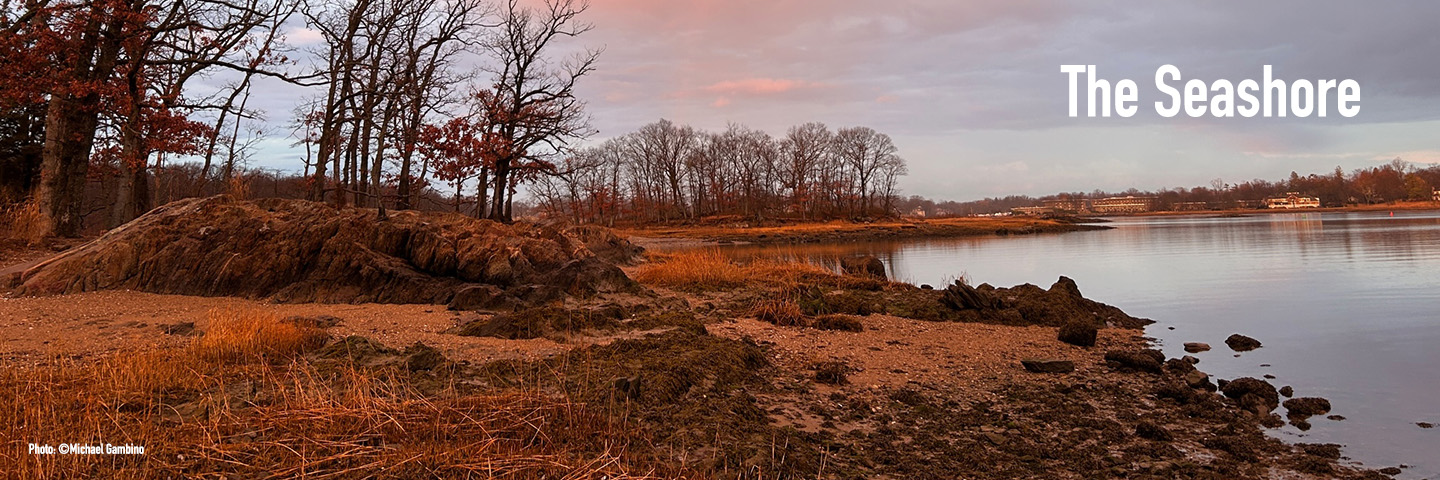A Place Where Life on the Land Meets Life in the Sea
Under the gravitational pull of the sun and the moon, the tides come in and out at the seashore twice a day. When the sun and moon are in line with our planet, the gravitational pull is stronger, resulting in the highest and the lowest tides. Waves are caused by the winds; the push and pull of the wind gives the water its rolling and rising motion. When a wave breaks on the seashore, it runs up the beach until its energy is exhausted. Waves crash against the outcrops of metamorphic rock and mica, gradually pulverizing them into smaller and smaller pieces, until they are reduced to particles of sand and are smooth to the touch. Seawater is a great reservoir of heat and profoundly affects climate.
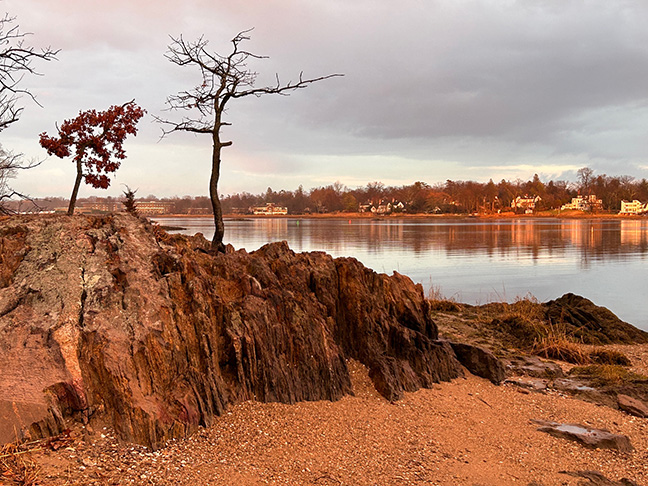 Photo: ©Michael Gambino
Photo: ©Michael GambinoExposed bedrock at the water’s edge composed of metamorphic rock, peppered with bands of the shiny mineral mica, rises through the coarse sand.
The Horseshoe Crab Has Come to This Shoreline for Over 10,000 Years
Life existed in the seas for millions of years before sea creatures moved onto the seashore and slowly expanded their territory further on to land. One of these ancient sea creatures is the American horseshoe crab (Limulus polphemus). The horseshoe crab originated 450 million years ago, long before Long Island Sound came into existence. They have changed little since then and are considered living fossils. This ancient sea animal comes to the seashore of the conservancy every year, as it has done for more than 10,000 years. They arrive at night on the first high tide of the first full moon in June to mate and lay their bright turquoise eggs. They are more closely related to spiders, ticks, and scorpions than crabs. They have a hard exoskeleton, which molts as they grow. They feed on small clams, crustaceans, and worms on the ocean floor and algae.
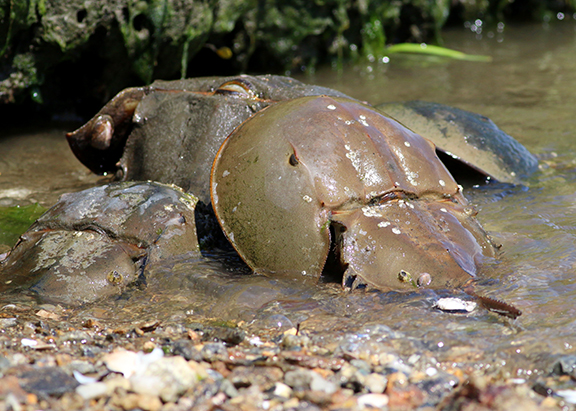 Photo: @Christina Baal
Photo: @Christina BaalEvery year on the first high tide of the first full moon in summer, horseshoe crabs (Limulus polphemus) come to the shoreline to mate and lay eggs
Horseshoe crabs remain at sea, coming to shore only to reproduce, once they are sexually mature, at ten years old. They live for about 20 years. Their blood is blue because of a protein containing copper, responsible for transporting oxygen in their blood plasma. The females release a pheromone to attract the males that fertilize their eggs, sometimes 90,000 per season. They use their tail spikes to steer and right themselves while swimming.
If you see a horseshoe crab on its back on the shore, gently pick it up (holding both sides of the shell, never the tail) and release it back into the water. Saving this species, and the many other species that depend on it is important.1 Vital to the shoreline ecosystem, their eggs and larvae are an important source of food for many migratory birds, including gulls and terns (Laridae). American horseshoe crabs are only found in North America along the Gulf and Atlantic coasts, from Maine to Mexico. Three other species are found only in Southeast Asia and the Indian and Pacific Oceans.
The Seashore is Visited Year-round by a Variety of Ducks and Wading Birds
This harbor has many winter visitors: bufflehead ducks (Bucephala albeola), hooded mergansers (Lophodytes cucullatus), and little bluebills or lesser scaups (Aythya affinis), along with terns (Laridae), and a variety of gulls (Laridae). Mallards (Anas platyrhynchos) can be seen year-round. In the summer months, majestic wading birds, like the snowy egret (Egretta thula) and great blue heron (Ardea herodias), can be seen hunting along the mudflats, stirring the mud with their feet to catch crustaceans or just standing still, watching for a fish to swim by.
Washed up on the seashore are rows of rockweed or bladder wrack (Fucus vesiculosis), red dulse (Palmaria palmata) and a red algae called Irish moss (Chondrus crispus). Seashells, significant to the culture of the Eastern Woodlands tribes, like the ocean quahog clam (Arctica islandica) are found here, as well as the Atlantic jacknife clam (Ensis directus) and the blue (Mytilus edulis) and ribbed mussel (Geukensia demissa). All are brought in on the high tide and stranded in the intertidal zone as the tide recedes. (See History).
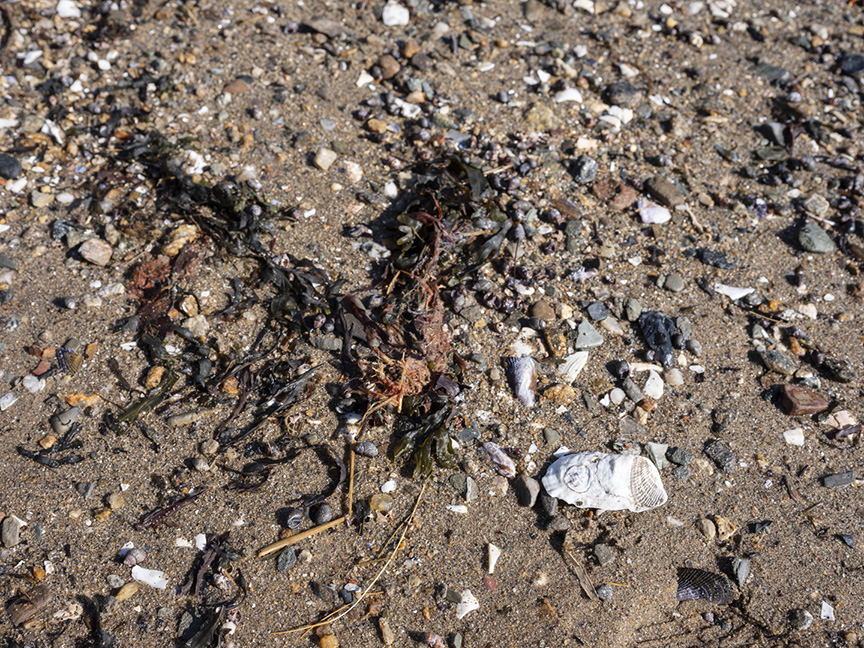 Photo: ©Rory Mulligan
Photo: ©Rory MulliganThe intertidal zone–strewn with different mollusk shells, seaweed, pebbles and glass
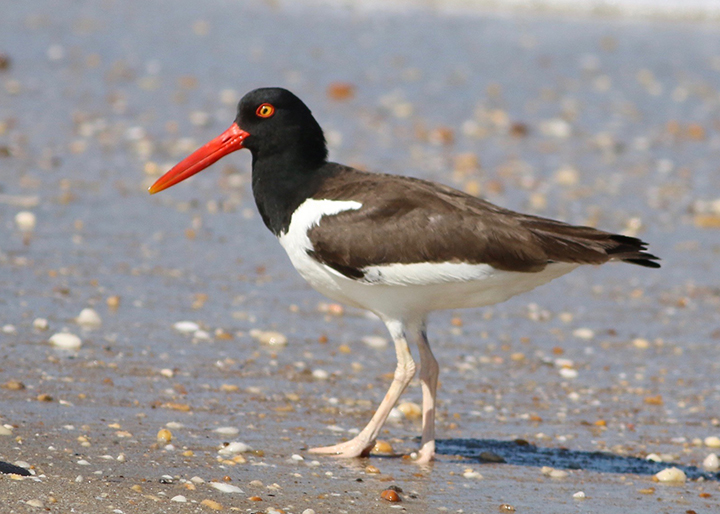 Photo: @Christina Baal
Photo: @Christina BaalAmerican oystercatcher (Haematopus palliatus)
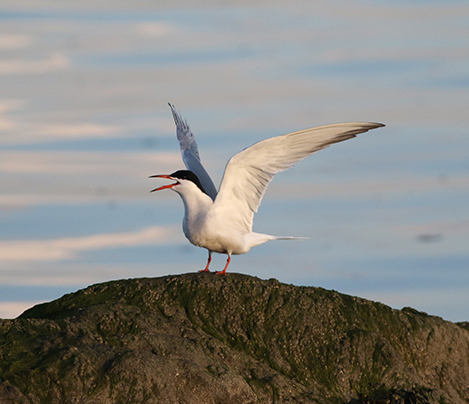 Photo: @Christina Baal
Photo: @Christina BaalCommon tern (Sterna hirundo)
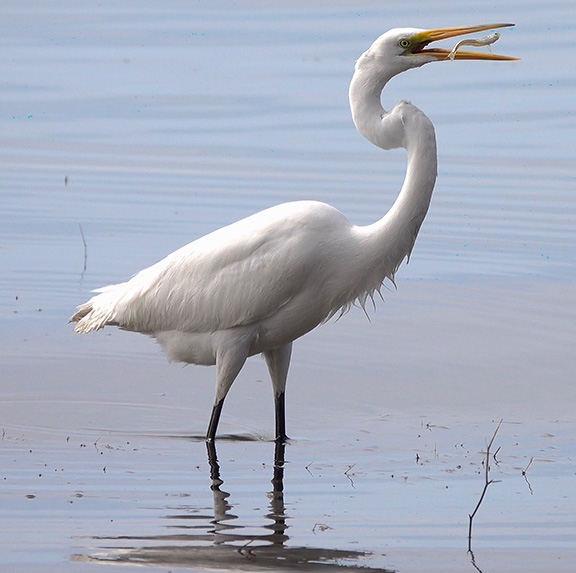 Photo: ©Ted Morano
Photo: ©Ted MoranoGreat egret (Ardea alba).
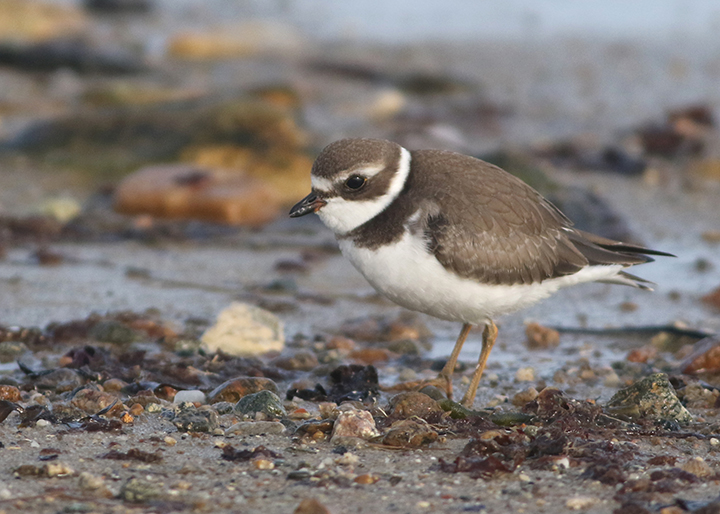 Photo: @Christina Baal
Photo: @Christina BaalSemipalmated plover (Charadrius semipalmatus)
All of the islands of the conservancy are natural, although some causeway trails leading out to some of the islands were built by the families living on this property in the 1800s. Although the islands have an elevation of ten feet at their highest, the land is high enough above the saltwater to allow trees to grow, like the post oak (Quercus stellata) and pignut hickory (Carya glabra), stunted by the harsh winds and storms that blow from the ocean. As testament to its North American origins, the name “hickory” derives from words in Algonquian and French. (See History).
On the beach and in rock pools many small, dark-green Asian shore crabs (Hemigrapsus sanguineus) scuttle about. Thought to have been brought in on water used as ships ballast, and then discharged when the ships were loaded with cargo, these opportunistic omnivores may out compete native species, like the fiddler crab.
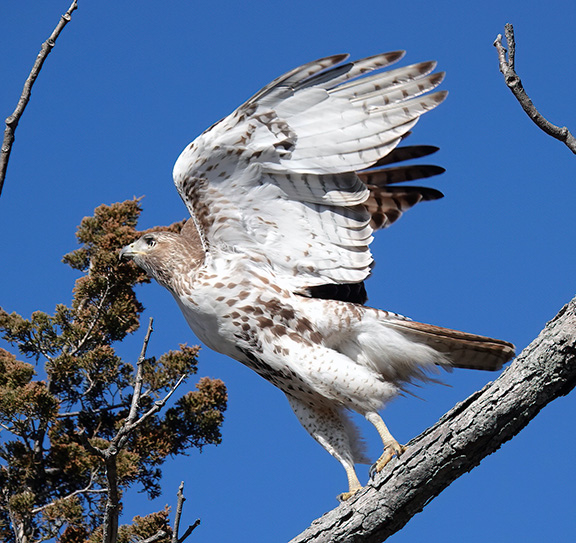 Photo: ©Ted Morano
Photo: ©Ted MoranoA young Red-tailed hawk (Buteo jamaicensis) getting ready for flight.
Notes
1 The milky-blue blood of the horseshoe crab is the only known natural source of limulus amebocyte lysate, a substance that detects contaminants called endotoxins. If even tiny amounts of endotoxins—types of bacterial toxins—make their way into vaccines, injectable drugs, or other sterile pharmaceuticals such as artificial knees and hips, the results can be deadly. Demand for horseshoe crab blood has grown exponentially for testing the safety of the COVID-19 vaccines. Source: Carrie Arnold, “Horseshoe Crab Blood is Key to Making COVID-19 Vaccine–But Ecosystems May Suffer,” National Geographic, July 2020. https://www.nationalgeographic.com/animals/2020/07/covid-vaccine-needs-horseshoe-crab-blood/.
Ten studies validate the efficacy of the synthetic alternative, dispelling lingering misconceptions and highlighting the opportunity for the pharmaceutical industry to immediately embrace a new detection technology for common manufacturing materials, which will reduce the need to bleed horseshoe crabs by 90 percent. Phased adoption will build the empirical data to confirm that synthetic endotoxin detection methods can be safely implemented, ending the industry’s dependence on animal-based technologies. This transition is a critical step in turning the tide for the horseshoe crab and for the migratory birds that rely upon them. Source: Tom Maloney, Ryan Phelan, and Naira Simmons, “Saving the Horseshoe Crab: A Synthetic Alternative to Horseshoe Crab Blood for Endotoxin Detection.” PLoS Biology 16, no. 10, doi: 10.1371/journal.pbio.2006607.
Adapted in part from Herbert S. Zim and Lester Ingle, Seashores: A Guide to Animals and Plants Along the Beaches. New York: Golden Press, 1991.
Sources and Further Reading:
The Cornell Lab of Ornithology. All About Birds. Cornell University, 2021. https://allaboutbirds.com
Davis, Mary B., comp. VIP (Volunteers in the Parks) Environmental Educator Course Outline.
Nassau County Museum of Natural History. The Shore. Seaford, NY.
National Oceanic and Atmospheric Administration, “How Does the Ocean Affect Climate and Weather on Land?”
National Ocean Service accessed February 8, 2021, oceanexplorer.noaa.gov/facts/climate.html.
Wikipedia.
THE FOREST THE MEADOWTHE SALT MARSHTHE SEASHORETHE POND
There is currently no content classified with this term.

